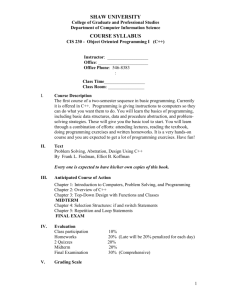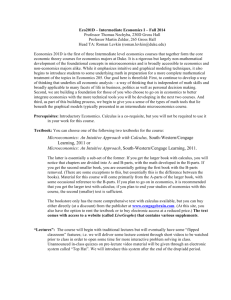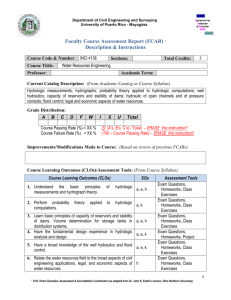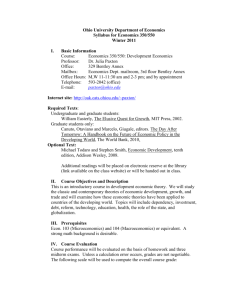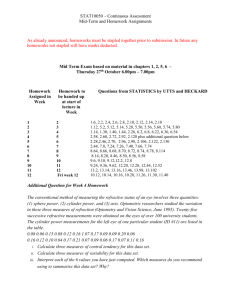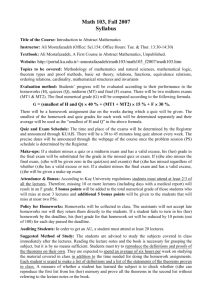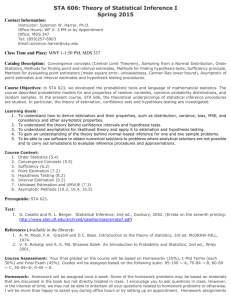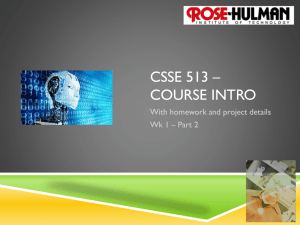Eco55D: Intermediate Economics I - Duke University Syllabus
advertisement
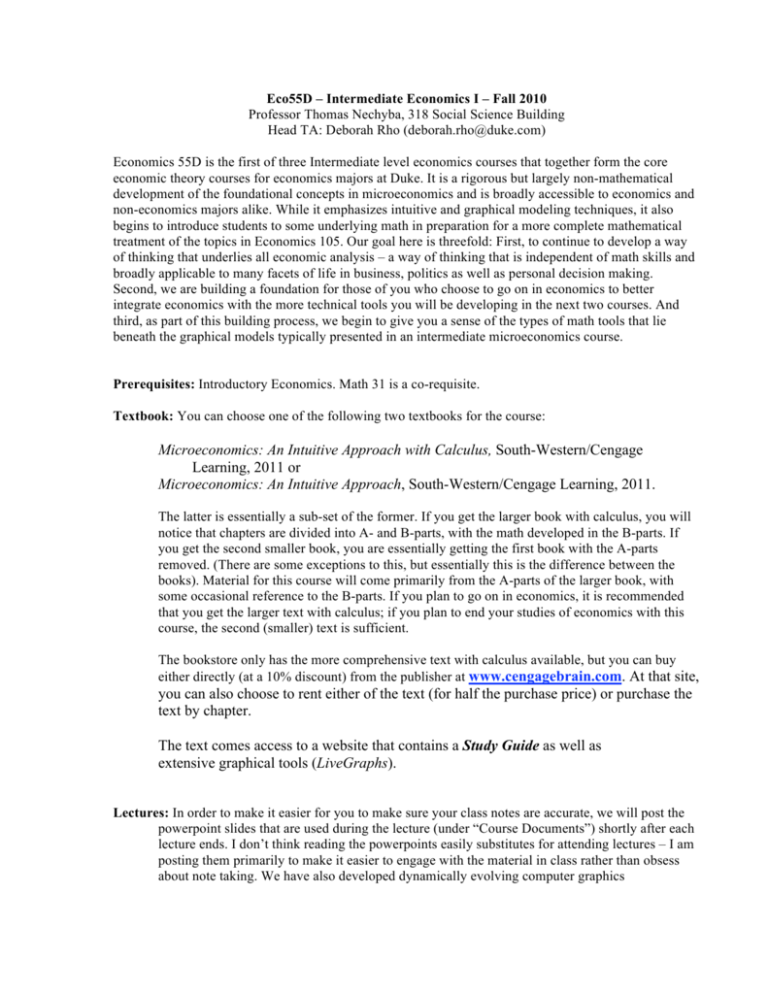
Eco55D – Intermediate Economics I – Fall 2010 Professor Thomas Nechyba, 318 Social Science Building Head TA: Deborah Rho (deborah.rho@duke.com) Economics 55D is the first of three Intermediate level economics courses that together form the core economic theory courses for economics majors at Duke. It is a rigorous but largely non-mathematical development of the foundational concepts in microeconomics and is broadly accessible to economics and non-economics majors alike. While it emphasizes intuitive and graphical modeling techniques, it also begins to introduce students to some underlying math in preparation for a more complete mathematical treatment of the topics in Economics 105. Our goal here is threefold: First, to continue to develop a way of thinking that underlies all economic analysis – a way of thinking that is independent of math skills and broadly applicable to many facets of life in business, politics as well as personal decision making. Second, we are building a foundation for those of you who choose to go on in economics to better integrate economics with the more technical tools you will be developing in the next two courses. And third, as part of this building process, we begin to give you a sense of the types of math tools that lie beneath the graphical models typically presented in an intermediate microeconomics course. Prerequisites: Introductory Economics. Math 31 is a co-requisite. Textbook: You can choose one of the following two textbooks for the course: Microeconomics: An Intuitive Approach with Calculus, South-Western/Cengage Learning, 2011 or Microeconomics: An Intuitive Approach, South-Western/Cengage Learning, 2011. The latter is essentially a sub-set of the former. If you get the larger book with calculus, you will notice that chapters are divided into A- and B-parts, with the math developed in the B-parts. If you get the second smaller book, you are essentially getting the first book with the A-parts removed. (There are some exceptions to this, but essentially this is the difference between the books). Material for this course will come primarily from the A-parts of the larger book, with some occasional reference to the B-parts. If you plan to go on in economics, it is recommended that you get the larger text with calculus; if you plan to end your studies of economics with this course, the second (smaller) text is sufficient. The bookstore only has the more comprehensive text with calculus available, but you can buy either directly (at a 10% discount) from the publisher at www.cengagebrain.com. At that site, you can also choose to rent either of the text (for half the purchase price) or purchase the text by chapter. The text comes access to a website that contains a Study Guide as well as extensive graphical tools (LiveGraphs). Lectures: In order to make it easier for you to make sure your class notes are accurate, we will post the powerpoint slides that are used during the lecture (under “Course Documents”) shortly after each lecture ends. I don’t think reading the powerpoints easily substitutes for attending lectures – I am posting them primarily to make it easier to engage with the material in class rather than obsess about note taking. We have also developed dynamically evolving computer graphics (LiveGraphs) for the text and the course. These are available at the publisher web-site you have access to, and they offer another way to “read” the text. You have also no doubt noticed that the course is scheduled for 3 rather than 2 lectures of an hour and fifteen minutes. In the past, I have taught the course in 3 lectures of 50 minutes each (per week). While this was sufficient time to cover the material for the course, it did not leave much room for me to illustrate how to tackle exercises and homework problems, and some extensions of the lecture material were left solely to sections. The extended lecture time will allow us to do more of this in class, with me essentially conducting much of what used to be covered in sections by TAs. Student feedback in the past has suggested that this was something students wanted to see more of, and my office hours were simply not large enough to accommodate demand. Sections: Given the increased emphasis on exercises and extensions within the lecture setting, sections this year can often be viewed more as extended office hours. As such, many of the sections will become strictly optional. At the same time, I may sometimes ask section leaders to cover some material we did not get to in lectures, or we may do some extra credit experiments in sections during certain weeks. I will let you know during lectures and via the web site each week what to expect in sections and the extent to which they are optional for that week. Finally, you should view your TAs and Section Leaders as a channel to voice concerns about the course in circumstances when you feel uncomfortable approaching me directly with such concerns. I will be meeting with all the TAs and Section leaders every week – and in those meetings I look for feedback on how things are going. Homework: Homework problems will be posted under “Assignments”, typically on Thursday morning. You will have one week to complete the homework problems which are due at the beginning of lecture at which time solutions will be posted. The purpose of the homeworks is to get you to work hands on with the conceptual material I present in class. Students often tell me that “it looks so easy when you do it in class, but then I can’t figure out how it relates to the homeworks.” In other words, the material can look easy in the abstract, but that is in part because there is no way to fully appreciate the nuances of the material without applying it. Taking these homeworks seriously is the single best way to study for this course. For many students, there is a great benefit from working on these homeworks in groups. In the past, we spent a lot of time grading homeworks individually and then returned them to students in sections. This turns out to be an enormous effort with relatively little payoff for you. Given the large number of students, we were never able to give good feedback on the homeworks themselves but instead relied on the solution sets to let you know where you went wrong. The only reason we asked students to hand in homeworks was to compel students to keep up with the material as we went along. In the end, almost all students received a high average grade on homeworks – which meant that grades were virtually unaffected by whether or not homeworks were averaged into the grades. We have therefore changed how we handle homework assignments. We will still collect them each week and will keep a record of who handed them in. You may not hand in up to two homeworks without this counting against you in any way. Then, at the end of the term, we will look at the homeworks of those whose course grade (in the absence of homeworks) is close to the borderline of a higher grade. If homeworks were handed in consistently and the quality of the work was good, we will then adjust grades for students who are close to a higher grade upward. One downside of this system is that, unless you make a copy of your homeworks prior to handing them in, you will only have the solutions sets (but not your own homework answers) to study from as the exams approach. If you want to have your own homework answers to study from, you therefore need to make a copy of your answers prior to handing them in. Office Hours: In order to help you with questions (on homeworks, lecture material, or anything else), we will have office hours in addition to sections throughout the week. These will be posted on the web site once we have fully organized them. You should feel free to attend office hours at any of the scheduled times, not just when your particular TA is holding his/her hours. Contacting Me: You should feel free to e-mail me when you have concerns but I urge you to get as much help as possible from TAs, the bulletin board (see below) and Sections. I will usually be in class a few minutes early and am happy to stay a few minutes late for short questions. Given the size of the class, it may be difficult to schedule individual appointments with me, but the easiest way for you to do so is by sending me an e-mail. Economics 55 Bulletin Board: We will set a course bulleting board (on the Blackboard site) on which you can post questions that will be answered by myself and a graduate TA. You can of course also see questions asked by others and the answers to those questions. Grading: Each student's course score will be calculated two ways, and the higher of the two will be used as the final score (prior to extra credit points being added). In the first method, the two midterm exam grades will count for 30% each, and the final exam counts for 40%. In the second method, the lower midterm exam grade will be dropped and the final exam grade will count for 70%. There are no make-up exams – if you miss a midterm exam, it will be dropped automatically under the second method. Once the final score is determined, extra credit points are added. I will advertise opportunities to earn extra credit throughout the course. The curve for the course will be applied at that point, with borderline B/B+ set as the median grade. We will then look at students whose scores fall close to the borderline of a higher grade and in those cases will take homework performance into account. Succeeding In Econ 55: First and foremost, you should plan to stay on top of the material in this course because the material builds. You cannot understand lecture 5 without understanding lectures 1 through 4. Students who fall behind do poorly in this course, and I think this is much more true for this course than for many others you will take. Second, teamwork helps many students. You can learn much from your peers – whether you teach them or are taught by them – as you struggle through homework problems and as you study. I therefore strongly recommend forming study and homework groups. Third, take the homeworks seriously. The material we cover in lectures can seem deceptively simple, and it is usually only in working with the material that you learn it at sufficient depth to do well on exams. In addition, I strongly recommend that you work through some of the within-chapter exercises as you read the chapters – they are intended for you to work immediately with concepts as you read about them. Fourth, you should learn to not panic when you do not know the answer to a question after reading the question. The course is trying to develop a way of thinking through problems – not just knowing the answers. Concentrate on developing strategies for approaching problems rather than just writing answers. Finally, if you find yourself falling behind, get help – from TAs, Sections, peers, bulletin boards and me. Course Outline: The following is a preliminary course outline. Details may change as we progress through the course, and I will alert you to these changes as they happen. Extra days denoted “Exercises and Extensions” are built into the syllabus to allow us time to work through problems and applications. COURSE OUTLINE Ausust September WEEK 1 30 1 3 Introduction Budgets Indifference Curves and Tastes Chapter 1A,B,C.4 Chapters 2A, 3A Chapter 4A, 5A WEEK 2 6* 8 10 Tastes and Optimization Income and Substitution Effects Exercises and Extensions Chapter 5A, 6A Chapter 7A 13 15 17 Dead Weight Loss (DWL) from Taxation No Class Consumer Demand and Labor Supply Chapter 8A WEEK 3 20 22 24 MWTP and DWL Revisited Exercises and Extensions Single Input Production Chapter 10A 27 29 1 2 Input Production Cost Minimization and Supply Midterm 1 Exam (in class) Chapter 12A.1-2 Chapter 12A.3-4 WEEK 4 WEEK 5 October WEEK 6 4* 6 8 Exercises and Extensions Long Run Supply and Substitution Effects Exercises and Extensions Chapter 9A Chapter 11A Chapter 13A.1-2 WEEK 7 11 13 15 FALL BREAK Competitive Industry Equilibrium The First Welfare Theorem WEEK 8 18 20 22 General Equilibrium and Welfare* Normative Economics Exercises and Extensions Chapter 16A Chapter 29A.3,4 WEEIK 9 25 27 29 Elasticities & Price Distorting Policies Taxes and Subsidies Immigration and Trade Chapter 18A Chapter 19A Chapter 20A Chapter 14A Chapter 15A November WEEK 10 1* 3 5 No class Externalities Midterm Exam 2 (in class) Chapter 21A WEEK 11 8 10 12 Asymmetric Information Discrimination Monopoly Chapter 22A.1-3 Chapter 22A.4-5 Chapter 23A WEEK 12 15 17 19 Game Theory I Game Theory II Exercises and Extensions Chapter 24A Chapter 24A 22 24 26 Oligopoly THANKSGIVING THANKSGIVING Chapter 25A WEEK 13 29 1 3 Product Differentiation Public Goods Governments and Politics Chapter 26A Chapter 27A.1-3 Chapter 28A 6 8 10 Behavioral Economics Risk and Uncertainty* Review Chapter 29A.1,2 Chapter 17A.1-2 17 FINAL EXAM, 2PM-5PM WEEK 14 December WEEK 15
